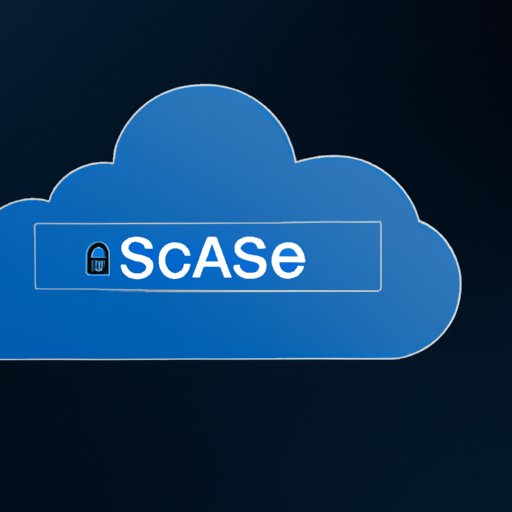Introduction
Secure Access Service Edge (SASE) is an emerging technology that provides secure access to cloud applications and services from any device or location. It combines features such as software-defined perimeter (SDP), network as a service (NaaS), identity and access management (IAM), and other security technologies for improved network security. This article will explore the definition and benefits of SASE technology, and examine the role it plays in modern network security. It will also explore the impact of SASE on cloud computing, and analyze the future of SASE technology.
Exploring SASE: What is Secure Access Service Edge Technology?
Secure Access Service Edge (SASE) is a cloud-based security framework designed to provide secure access to applications and services from any device or location. It combines multiple security technologies such as software-defined perimeter (SDP), network as a service (NaaS), identity and access management (IAM), and other security solutions into a single unified platform. SASE is designed to protect organizations from cyber threats by providing enhanced network security, improved data protection, and improved visibility into network activity.

Understanding the Benefits of SASE for Businesses
SASE offers numerous benefits to businesses, including improved security and compliance, increased efficiency and productivity, and cost and resource savings. By deploying SASE technology, businesses can improve their security posture by protecting against cyber threats, while also improving their ability to comply with industry regulations. Additionally, SASE can help increase efficiency and productivity by simplifying the process of securely accessing applications and data from any device or location. Finally, SASE can help businesses save costs by reducing the need for additional hardware and software investments.
How SASE Can Help Protect Your Organization from Cyber Threats
SASE can help protect your organization from cyber threats by providing enhanced network security, improved data protection, and improved visibility into network activity. SASE provides advanced encryption and authentication capabilities to ensure all data is protected from unauthorized access. Additionally, SASE can help improve visibility into network activity by providing detailed logs and reports of user activity. This allows IT teams to quickly identify suspicious activity and take appropriate action to mitigate any potential risks.

The Role of SASE in Modern Network Security
SASE is playing an increasingly important role in modern network security. It enables secure connectivity between users, applications, and services, regardless of their physical location. Additionally, SASE can enhance application performance by offloading security tasks to the cloud and improving response times. Finally, SASE can support cloud adoption by providing secure access to cloud applications and services.

An Overview of the Different Components of SASE
SASE is composed of several key components, including software-defined perimeter (SDP), network as a service (NaaS), and identity and access management (IAM). Software-defined perimeter (SDP) helps ensure secure connections to applications and services by providing encryption and authentication capabilities. Network as a service (NaaS) provides a secure, virtualized infrastructure for hosting applications and services. Finally, identity and access management (IAM) helps manage user access to applications and services, and ensures that only authorized users are able to access sensitive data.
Examining the Impact of SASE on Cloud Computing
SASE can have a positive impact on cloud computing by improving security and visibility, increasing agility and scalability, and reducing complexity and overhead. SASE provides enhanced security and visibility by allowing organizations to control access to applications and services, and monitor user activity. Additionally, SASE can help increase agility and scalability by enabling organizations to quickly deploy new applications and services without having to invest in additional hardware and software. Finally, SASE can reduce complexity and overhead by eliminating the need for manual configuration and maintenance.
Analyzing the Future of SASE Technology
The demand for SASE solutions is expected to grow significantly in the coming years. This is due to the increasing number of companies adopting cloud computing, as well as advances in security technologies. Additionally, organizations are looking for ways to reduce costs associated with network security, and SASE can help them achieve this. As more organizations adopt SASE technology, we can expect to see further advances in security solutions, and greater opportunities to reduce costs.
Conclusion
Secure Access Service Edge (SASE) technology is an emerging security framework designed to provide secure access to applications and services from any device or location. It combines multiple security technologies such as software-defined perimeter (SDP), network as a service (NaaS), identity and access management (IAM), and other security solutions into a single unified platform. SASE offers numerous benefits to businesses, including improved security and compliance, increased efficiency and productivity, and cost and resource savings. Additionally, SASE can help protect organizations from cyber threats by providing enhanced network security, improved data protection, and improved visibility into network activity. The demand for SASE solutions is expected to grow significantly in the coming years, as organizations look for ways to reduce costs associated with network security.
(Note: Is this article not meeting your expectations? Do you have knowledge or insights to share? Unlock new opportunities and expand your reach by joining our authors team. Click Registration to join us and share your expertise with our readers.)
